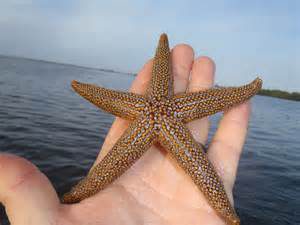One of the more popular traditions this time of year is placing the star on top of the Christmas Tree. The star represents the Christmas Star which led the wise men to the manager. The stars that have been placed on Christmas Trees over the decades have come in all shapes and forms but gulf coast residents will use a starfish to both represent the Nativity and their connection to the sea.
Starfish, more correctly called sea stars, are one of the most recognized marine creatures in the world. Many have used it as a logo or their symbol of the sea. But what is a sea star actually? We know they live on the bottom and look like stars but what do they do? How do they function?
Sea stars are invertebrates in the Phylum Echinodermata. Echinoderms have radial symmetry; meaning they have a distinct top and bottom but no head or tail. You certainly know if it is upside down but you are not sure if it is facing you. They are the only invertebrates to have an internal skeleton; called a test. It is this skeleton we find in the curio shops and stores – and what we place on our tree. This skeleton produces tubercules or spines which extend into (and above) the skin – giving them the “spiny skin” for which they get their name – “echino” “derm”. Echinoderms have a series of tube like sacs underneath their bodies which they fill with water and use like suction cups to move and feed. Most have male and females and all produce planktonic larva.
Sea stars in particular are found worldwide and are more common in coastal waters. They come in a variety of colors and most have five arms – though one species has 40! Their mouth is on the underside of the body and lacks teeth. They have a pigment spot at the end of each arm that can detect light. Some sea stars are attracted to light, while others are repelled by it. Most sea stars are carnivorous, feeding on a variety of invertebrates including other echinoderms, and some are scavengers. Mollusk are a common prey, and – to the dismay of oyster farmers – oysters are an easy prey. The sea stars approach the bivalve, use their tube feet to open the two shells slightly, and insert their digestive tract inside the oyster. They attack the abductor muscle first, release the tension on the two shells, and then consume the rest of the animal. Sea stars like seawater, so oysters growing in the upper estuaries have fewer problems with these predators. Our local sea stars are good at detecting buried prey in our quartz sand and then digging them out. These animals are famous for their ability to regenerate their body parts. Oyster farmers trying to reduce this threat have been known to cut them and toss them back, only to have more sea stars later. However sexual reproduction is also very common. Most sea stars have 2 gonads per arm and can fertilize up to 2 million eggs in a spawning event. Spawning is usually in the spring and is triggered by chemicals in the water.
Though they are a classic icon for the ocean, and holiday decoration along the coast, these are fascinating animals in their own right. I wish all of you Happy Holidays and a joyous new year.
- Rattlesnakes on Our Barrier Islands; Part 4 – Thermoregulation - December 29, 2025
- Rattlesnakes on Our Barrier Islands; Part 3 – Envenomation - December 22, 2025
- St. Joe Red Tide Claiming Terrapins - December 15, 2025

